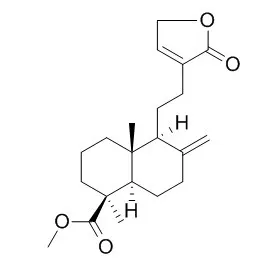| In vitro: |
| Br J Pharmacol. 2007 Jan;150(1):65-71. | | Pinusolide and 15-methoxypinusolidic acid attenuate the neurotoxic effect of staurosporine in primary cultures of rat cortical cells.[Pubmed: 17143305] | Apoptosis is a fundamental process required for neuronal development but also occurs in most of the common neurodegenerative disorders. In an attempt to obtain an anti-apoptotic neuroprotective compound from natural products, we isolated the diterpenoids, Pinusolide and 15-MPA, from B. orientalis and investigated their neuroprotective activity against staurosporine (STS) -induced neuronal apoptosis. In addition, we determined the anti-apoptotic mechanism of these compounds in rat cortical cells.
METHODS AND RESULTS:
Primary cultures of rat cortical cells injured by STS were used as an in vitro assay system. Cells were pretreated with Pinusolide or 15-MPA before exposure to STS. Anti-apoptotic activities were evaluated by the measurement of cytoplasmic condensation and nuclear fragmentation. The levels of cellular peroxide, malondialdehyde (MDA) and [Ca(2+)]i, as well as the activities of superoxide dismutase (SOD) and caspase-3/7, were measured.
Pinusolide and 15-MPA, at a concentration of 5.0 ìM, reduced the condensed nuclei and rise in [Ca(2+)]i that accompanies apoptosis induced by 100 nM STS. Pinusolide and 15-MPA also protected the cellular activity of SOD, an antioxidative enzyme reduced by STS insult. Furthermore, the overproduction of reactive oxygen species and lipid peroxidation induced by STS was significantly reduced in Pinusolide and 15-MPA treated cells. In addition, Pinusolide and 15-MPA inhibited STS-induced caspase-3/7 activation.
CONCLUSIONS:
These results show that Pinusolide and 15-MPA protect neuronal cells from STS-induced apoptosis, probably by preventing the increase in [Ca(2+)]i and cellular oxidation caused by STS, and indicate that they could be used to treat neurodegenerative diseases. | | Planta Med. 1999 Feb;65(1):39-42. | | Pinusolide from the leaves of Biota orientalis as potent platelet activating factor antagonist.[Pubmed: 10083843] | We investigated the effect of a new PAF antagonist Pinusolide, isolated from the leaves of Biota orientalis, on PAF-induced [3H]serotinin release from rabbit platelets, hypotension and vascular permeability.
METHODS AND RESULTS:
Pinusolide (IC50, about 5 x 10(-6) M) inhibited specifically [3H]serotinin release from rabbit platelets when stimulated with PAF (5 x 10(-8) M), but showed no effect when induced by ADP, collagen, and thrombin. It also inhibited PAF-induced hypotension in a dose-dependent manner in rats with no effect on the hypotension induced by acetylcholine, histamine and serotonin. The inhibitory effect of Pinusolide on the PAF-induced vascular permeability is less specific than the induced hypotension.
CONCLUSIONS:
These results suggest that Pinusolide may prove of therapeutic value in the treatment of hypotension and a molecular design of Pinusolide analogues may provide the possibility of a new PAF specific antagonists. | | Bioorg Med Chem Lett. 2006 Aug 15;16(16):4228-32. | | Gram-scale synthesis of pinusolide and evaluation of its antileukemic potential.[Pubmed: 16781150 ] |
METHODS AND RESULTS:
Pinusolide (1), a known platelet-activating factor (PAF) receptor binding antagonist, was synthesized from lambertianic acid (2), a labdane-type diterpene readily accessible in multigram quantities from the Siberian pine tree.
CONCLUSIONS:
It was shown that 1 not only decreases the proliferation activity of tumor cells at relatively low concentrations but specifically induces apoptosis at 100 microM via the mitochondrial pathway in the Burkitt lymphoma cell line BJAB. Also, using primary lymphoblasts and leukemic cells from children with acute lymphoblastic leukemia (ALL) and acute myeloid leukemia (AML), a significant DNA fragmentation in Pinusolide-treated cells could be detected in an ex vivo apoptosis assay. |
|






 Cell. 2018 Jan 11;172(1-2):249-261.e12. doi: 10.1016/j.cell.2017.12.019.IF=36.216(2019)
Cell. 2018 Jan 11;172(1-2):249-261.e12. doi: 10.1016/j.cell.2017.12.019.IF=36.216(2019) Cell Metab. 2020 Mar 3;31(3):534-548.e5. doi: 10.1016/j.cmet.2020.01.002.IF=22.415(2019)
Cell Metab. 2020 Mar 3;31(3):534-548.e5. doi: 10.1016/j.cmet.2020.01.002.IF=22.415(2019) Mol Cell. 2017 Nov 16;68(4):673-685.e6. doi: 10.1016/j.molcel.2017.10.022.IF=14.548(2019)
Mol Cell. 2017 Nov 16;68(4):673-685.e6. doi: 10.1016/j.molcel.2017.10.022.IF=14.548(2019)